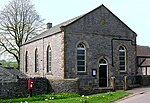Hurdlow railway station
Disused railway stations in DerbyshireFormer London and North Western Railway stationsPages with no open date in Infobox stationRailway stations in Great Britain closed in 1949Railway stations in Great Britain opened in 1856 ... and 1 more
Use British English from May 2017

Hurdlow railway station was near to the hamlet of Hurdlow within Hartington Middle Quarter civil parish, to the south east of Buxton, Derbyshire on the LNWR line to Ashbourne and the south.
Excerpt from the Wikipedia article Hurdlow railway station (License: CC BY-SA 3.0, Authors, Images).Hurdlow railway station
Tagg Lane, Derbyshire Dales Hartington Middle Quarter CP
Geographical coordinates (GPS) Address Nearby Places Show on map
Geographical coordinates (GPS)
| Latitude | Longitude |
|---|---|
| N 53.1914 ° | E -1.8106 ° |
Address
Tagg Lane
Tagg Lane
SK17 9QJ Derbyshire Dales, Hartington Middle Quarter CP
England, United Kingdom
Open on Google Maps









